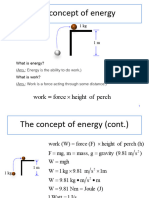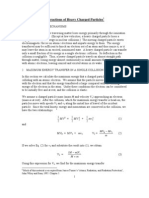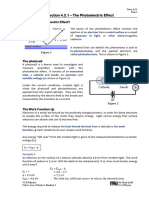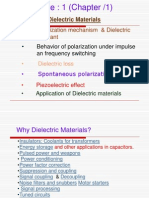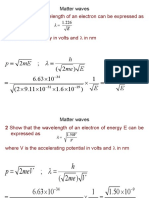Professional Documents
Culture Documents
Electronvolt - Wikipedia
Electronvolt - Wikipedia
Uploaded by
Braian De LeonCopyright
Available Formats
Share this document
Did you find this document useful?
Is this content inappropriate?
Report this DocumentCopyright:
Available Formats
Electronvolt - Wikipedia
Electronvolt - Wikipedia
Uploaded by
Braian De LeonCopyright:
Available Formats
Not logged in Talk Contributions Create account Log in
Article Talk Read Edit View history Search Wikipedia
Electronvolt
From Wikipedia, the free encyclopedia
Main page "meV", "keV", "MeV", "GeV", "TeV" and "PeV" redirect here. For other uses, see MEV, KEV, GEV, TEV and
Contents PEV.
Current events
In physics, an electronvolt (symbol eV, also written electron-volt and electron volt) is the measure of an
Random article
About Wikipedia amount of kinetic energy gained by a single electron accelerating from rest through an electric potential
Contact us difference of one volt in vacuum. When used as a unit of energy, the numerical value of 1 eV in joules (symbol J)
Donate is equivalent to the numerical value of the charge of an electron in coulombs (symbol C). Under the 2019
redefinition of the SI base units, this sets 1 eV equal to the exact value 1.602 176 634 × 10−19 J.[1]
Contribute
Historically, the electronvolt was devised as a standard unit of measure through its usefulness in electrostatic
Help
particle accelerator sciences, because a particle with electric charge q has an energy E = qV after passing
Learn to edit
Community portal through the potential V; if q is quoted in integer units of the elementary charge and the potential in volts, one gets
Recent changes an energy in eV.
Upload file It is a common unit of energy within physics, widely used in solid state, atomic, nuclear, and particle physics. It is
Tools commonly used with the metric prefixes milli-, kilo-, mega-, giga-, tera-, peta- or exa- (meV, keV, MeV, GeV, TeV,
PeV and EeV respectively). In some older documents, and in the name Bevatron, the symbol BeV is used, which
What links here
stands for billion (109) electronvolts; it is equivalent to the GeV.
Related changes
Special pages Measurement Unit SI value of unit
Contents [hide]
Permanent link
Page information
1 Definition Energy eV 1.602 176 634 × 10−19 J
2 Mass
Cite this page Mass eV/c2 1.782 662 × 10−36 kg
Wikidata item 3 Momentum
Momentum eV/c 5.344 286 × 10−28 kg·m/s
4 Distance
Print/export Temperature eV/kB 1.160 451 812 × 104 K
5 Temperature
Download as PDF
6 Properties Time ħ/eV 6.582 119 × 10−16 s
Printable version
7 Scattering experiments
Distance ħc/eV 1.973 27 × 10−7 m
Languages 8 Energy comparisons
العربية 8.1 Per mole
Čeština 9 See also
Español 10 References
िहन्दी 11 External links
Bahasa Indonesia
Bahasa Melayu
Русский Definition [ edit ]
!"#$ An electronvolt is the amount of kinetic energy gained or lost by a single electron accelerating from rest through
an electric potential difference of one volt in vacuum. Hence, it has a value of one volt, 1 J/C, multiplied by the
71 more electron's elementary charge e, 1.602 176 634 × 10−19 C.[2] Therefore, one electronvolt is equal to
1.602 176 634 × 10−19 J.[3]
Edit links
The electronvolt, as opposed to the volt, is not an SI unit. The electronvolt (eV) is a unit of energy whereas the
volt (V) is the derived SI unit of electric potential. The SI unit for energy is the joule (J).
Mass [ edit ]
By mass–energy equivalence, the electronvolt is also a unit of mass. It is common in particle physics, where
units of mass and energy are often interchanged, to express mass in units of eV/c2, where c is the speed of light
in vacuum (from E = mc2). It is common to simply express mass in terms of "eV" as a unit of mass, effectively
using a system of natural units with c set to 1.[4] The mass equivalent of 1 eV/c2 is
For example, an electron and a positron, each with a mass of 0.511 MeV/c2, can annihilate to yield 1.022 MeV of
energy. The proton has a mass of 0.938 GeV/c2. In general, the masses of all hadrons are of the order of
1 GeV/c2, which makes the GeV (gigaelectronvolt) a convenient unit of mass for particle physics:
1 GeV/c2 = 1.782 661 92 × 10−27 kg.
The unified atomic mass unit (u), almost exactly 1 gram divided by the Avogadro number, is almost the mass of
a hydrogen atom, which is mostly the mass of the proton. To convert to electron volts, use the formula:
1 u = 931.4941 MeV/c2 = 0.931 4941 GeV/c2.
Momentum [ edit ]
In high-energy physics, the electronvolt is often used as a unit of momentum. A potential difference of 1 volt
causes an electron to gain an amount of energy (i.e., 1 eV). This gives rise to usage of eV (and keV, MeV, GeV
or TeV) as units of momentum, for the energy supplied results in acceleration of the particle.
The dimensions of momentum units are T−1LM. The dimensions of energy units are T−2L2M. Then, dividing the
units of energy (such as eV) by a fundamental constant that has units of velocity (T−1L), facilitates the required
conversion of using energy units to describe momentum. In the field of high-energy particle physics, the
fundamental velocity unit is the speed of light in vacuum c.
By dividing energy in eV by the speed of light, one can describe the momentum of an electron in units of eV/c.[5]
[6]
The fundamental velocity constant c is often dropped from the units of momentum by way of defining units of
length such that the value of c is unity. For example, if the momentum p of an electron is said to be 1 GeV, then
the conversion to MKS can be achieved by:
Distance [ edit ]
In particle physics, a system of "natural units" in which the speed of light in vacuum c and the reduced Planck
constant ħ are dimensionless and equal to unity is widely used: c = ħ = 1. In these units, both distances and
times are expressed in inverse energy units (while energy and mass are expressed in the same units, see
mass–energy equivalence). In particular, particle scattering lengths are often presented in units of inverse
particle masses.
Outside this system of units, the conversion factors between electronvolt, second, and nanometer are the
following:
The above relations also allow expressing the mean lifetime τ of an unstable particle (in seconds) in terms of its
decay width Γ (in eV) via Γ = ħ/τ. For example, the B0 meson has a lifetime of 1.530(9) picoseconds, mean
decay length is cτ = 459.7 μm, or a decay width of (4.302 ± 25) × 10−4 eV.
Conversely, the tiny meson mass differences responsible for meson oscillations are often expressed in the more
convenient inverse picoseconds.
Energy in electronvolts is sometimes expressed through the wavelength of light with photons of the same
energy:
Temperature [ edit ]
In certain fields, such as plasma physics, it is convenient to use the electronvolt to express temperature. The
electronvolt is divided by the Boltzmann constant to convert to the Kelvin scale:
Where kB is the Boltzmann constant, K is Kelvin, J is Joules, eV is electronvolts.
The kB is assumed when using the electronvolt to express temperature, for example, a typical magnetic
confinement fusion plasma is 15 keV (kilo-electronvolts), which is equal to 170 MK (million Kelvin).
290 K
As an approximation: kBT is about 0.025 eV (≈ 11604 K/eV ) at a temperature of 20 °C.
Properties [ edit ]
The energy E, frequency v, and wavelength λ of a photon are related by
Energy of photons in the visible
spectrum in eV
where h is the Planck constant, c is the speed of light. This reduces to[1]
A photon with a wavelength of 532 nm (green light) would have an energy of
Graph of wavelength (nm) to
approximately 2.33 eV. Similarly, 1 eV would correspond to an infrared
energy (eV)
photon of wavelength 1240 nm or frequency 241.8 THz.
Scattering experiments [ edit ]
In a low-energy nuclear scattering experiment, it is conventional to refer to the nuclear recoil energy in units of
eVr, keVr, etc. This distinguishes the nuclear recoil energy from the "electron equivalent" recoil energy (eVee,
keVee, etc.) measured by scintillation light. For example, the yield of a phototube is measured in phe/keVee
(photoelectrons per keV electron-equivalent energy). The relationship between eV, eVr, and eVee depends on
the medium the scattering takes place in, and must be established empirically for each material.
Energy comparisons [ edit ]
Energy Source
total energy released from a 20 kt nuclear
5.25 × 1032 eV
fission device
1.22 × 1028 eV the Planck energy
10 YeV
approximate grand unification energy
(1 × 1025 eV)
energy consumed by a single 100-watt
~624 EeV
light bulb in one second (100 W = 100 J/s
(6.24 × 1020 eV)
≈ 6.24 × 1020 eV/s)
300 EeV The first ultra-high-energy cosmic ray
(3 × 1020 eV = particle observed, the so-called Oh-My-
~50 J) God particle.[10]
two petaelectronvolts, the most high-
energetic neutrino detected by the
2 PeV
IceCube neutrino telescope in
Antarctica[11]
designed proton center-of-mass collision Photon frequency vs. energy particle in
electronvolts. The energy of a photon varies only
energy at the Large Hadron Collider with the frequency of the photon, related by speed
14 TeV (operated at 3.5 TeV since its start on 30 of light constant. This contrasts with a massive
particle of which the energy depends on its velocity
March 2010, reached 13 TeV in May
and rest mass.[7][8][9] Legend
2015) MIR: Mid
γ: Gamma rays HF: High freq.
infrared
a trillion electronvolts, or 1.602 × 10−7 J,
HX: Hard X- MF: Medium
1 TeV about the kinetic energy of a flying FIR: Far infrared
rays freq.
mosquito[12] SX: Soft X-rays Radio waves LF: Low freq.
EUV: Extreme EHF: Extremely VLF: Very low
rest energy of top quark, the heaviest ultraviolet high freq. freq.
172 GeV
measured elementary particle NUV: Near SHF: Super high VF/ULF: Voice
ultraviolet freq. freq.
energy corresponding to the mass of the UHF: Ultra high SLF: Super low
Visible light
Higgs boson, as measured by two freq. freq.
125.1±0.2 GeV NIR: Near VHF: Very high ELF: Extremely
separate detectors at the LHC to a
Infrared freq. low freq.
certainty better than 5 sigma[13] Freq:
Frequency
average energy released in fission of one
210 MeV
Pu-239 atom
approximate average energy released in
200 MeV nuclear fission fission fragments of one
U-235 atom.
105.7 MeV rest energy of a muon
average energy released in the nuclear
fusion of deuterium and tritium to form
17.6 MeV
He-4; this is 0.41 PJ per kilogram of
product produced
approximate average energy released in
2 MeV a nuclear fission neutron released from
one U-235 atom.
rest energy of up quark, the lowest mass
1.9 MeV
quark.
1 MeV
about twice the rest energy of an electron
(1.602 × 10−13 J)
approximate thermal temperature, ,
in nuclear fusion systems, like the core of
1 to 10 keV
the sun, magnetically confined plasma,
inertial confinement and nuclear weapons
the energy required to ionize atomic
13.6 eV hydrogen; molecular bond energies are
on the order of 1 eV to 10 eV per bond
1.6 eV to 3.4 eV the photon energy of visible light
energy required to break a covalent
1.1 eV
bond in silicon
energy required to break a covalent
720 meV
bond in germanium
approximate rest energy of neutrinos
< 120 meV
(sum of 3 flavors)[14]
thermal energy, , at room
25 meV temperature; one air molecule has an
average kinetic energy 38 meV
thermal energy, , of the cosmic
230 μeV
microwave background
Per mole [ edit ]
One mole of particles given 1 eV of energy has approximately 96.5 kJ of energy – this corresponds to the
Faraday constant (F ≈ 96 485 C mol−1), where the energy in joules of n moles of particles each with energy E eV
is equal to E·F·n.
See also [ edit ]
Orders of magnitude (energy)
References [ edit ]
1. ^ a b "CODATA Value: Planck constant in eV s" . Archived from the original on 22 January 2015. Retrieved 30 March 2015.
2. ^ "2018 CODATA Value: elementary charge" . The NIST Reference on Constants, Units, and Uncertainty. NIST. 20 May
2019. Retrieved 2019-05-20.
3. ^ "2018 CODATA Value: electron volt" . The NIST Reference on Constants, Units, and Uncertainty. NIST. 20 May 2019.
Retrieved 2019-05-20.
4. ^ Barrow, J. D. "Natural Units Before Planck." Quarterly Journal of the Royal Astronomical Society 24 (1983): 24.
5. ^ "Units in particle physics" . Associate Teacher Institute Toolkit. Fermilab. 22 March 2002. Archived from the original on
14 May 2011. Retrieved 13 February 2011.
6. ^ "Special Relativity" . Virtual Visitor Center. SLAC. 15 June 2009. Retrieved 13 February 2011.
7. ^ What is Light? Archived December 5, 2013, at the Wayback Machine – UC Davis lecture slides
8. ^ Elert, Glenn. "Electromagnetic Spectrum, The Physics Hypertextbook" . hypertextbook.com. Archived from the original on
2016-07-29. Retrieved 2016-07-30.
9. ^ "Definition of frequency bands on" . Vlf.it. Archived from the original on 2010-04-30. Retrieved 2010-10-16.
10. ^ Open Questions in Physics. Archived 2014-08-08 at the Wayback Machine German Electron-Synchrotron. A Research
Centre of the Helmholtz Association. Updated March 2006 by JCB. Original by John Baez.
11. ^ "A growing astrophysical neutrino signal in IceCube now features a 2-PeV neutrino" . Archived from the original on 2015-
03-19.
12. ^ Glossary Archived 2014-09-15 at the Wayback Machine - CMS Collaboration, CERN
13. ^ ATLAS; CMS (26 March 2015). "Combined Measurement of the Higgs Boson Mass in pp Collisions at √s=7 and 8 TeV with the
ATLAS and CMS Experiments" . Physical Review Letters. 114 (19): 191803. arXiv:1503.07589 .
Bibcode:2015PhRvL.114s1803A . doi:10.1103/PhysRevLett.114.191803 . PMID 26024162 .
14. ^ Mertens, Susanne (2016). "Direct neutrino mass experiments". Journal of Physics: Conference Series. 718 (2): 022013.
arXiv:1605.01579 . Bibcode:2016JPhCS.718b2013M . doi:10.1088/1742-6596/718/2/022013 . S2CID 56355240 .
External links [ edit ]
BIPM's definition of the electronvolt
physical constants reference; CODATA data
V ·T ·E SI units [hide]
Base units ampere · candela · kelvin · kilogram · metre · mole · second
becquerel · coulomb · degree Celsius · farad · gray · henry · hertz · joule · katal ·
Derived units
lumen · lux · newton · ohm · pascal · radian · siemens · sievert · steradian · tesla ·
with special names
volt · watt · weber
astronomical unit · dalton · day · decibel · degree of arc · electronvolt · hectare ·
Other accepted units
hour · litre · minute · minute and second of arc · neper · tonne
Conversion of units · Metric prefixes · 2005–2019 definition · 2019 redefinition ·
See also
Systems of measurement
Category
Categories: Particle physics Units of chemical measurement Units of energy Voltage
This page was last edited on 27 September 2021, at 18:21 (UTC).
Text is available under the Creative Commons Attribution-ShareAlike License; additional terms may apply. By using this site, you
agree to the Terms of Use and Privacy Policy. Wikipedia® is a registered trademark of the Wikimedia Foundation, Inc., a non-profit
organization.
Privacy policy About Wikipedia Disclaimers Contact Wikipedia Mobile view Developers Statistics Cookie statement
You might also like
- Electric Potential LabDocument8 pagesElectric Potential Labkatelyn ibarra50% (2)
- Physics of Radiology and ImagingDocument426 pagesPhysics of Radiology and ImagingFlorentina Andronescu100% (1)
- (Thomas P. Pearsall) Photonics Essentials An Intr (BookFi)Document284 pages(Thomas P. Pearsall) Photonics Essentials An Intr (BookFi)Arturo EspinoNo ratings yet
- Electronvolt - Wikipedia, The Free EncyclopediaDocument2 pagesElectronvolt - Wikipedia, The Free Encyclopediadonodoni0008No ratings yet
- Electron Volt (Symbol Ev Also Written ElectronvoltDocument2 pagesElectron Volt (Symbol Ev Also Written ElectronvoltsenthilanviewNo ratings yet
- PART 1 SHORT LECTURE K30 21dec 2020Document27 pagesPART 1 SHORT LECTURE K30 21dec 2020Hgwergweg GwqegwNo ratings yet
- EEE2203 PHYSICAL ELECTRONICS II Lesson1Document11 pagesEEE2203 PHYSICAL ELECTRONICS II Lesson1FrancisNo ratings yet
- Modern Physics: Larry D. Buban, Ph.D. (Scied - Physics)Document47 pagesModern Physics: Larry D. Buban, Ph.D. (Scied - Physics)Hannah Grace Romano ViceralNo ratings yet
- Chapter11 Part1 PDFDocument40 pagesChapter11 Part1 PDFvampanezezNo ratings yet
- 2 - JNE1N4!5!20 - Characteristics of High-Density Charge Clusters - A Theoretical ModelDocument16 pages2 - JNE1N4!5!20 - Characteristics of High-Density Charge Clusters - A Theoretical ModelNightWolf5No ratings yet
- 2019-Key Physics Equations and Experiments Explained and Derived by Energy Wave EquationsDocument29 pages2019-Key Physics Equations and Experiments Explained and Derived by Energy Wave Equationsjoao pedro GomesNo ratings yet
- Units Translation of NanotechnologyDocument3 pagesUnits Translation of NanotechnologyafaqunaNo ratings yet
- Photo CatalystDocument7 pagesPhoto Catalystyasamin shajiratiNo ratings yet
- Teori Kimia Radiasi Pertemuan Ke 2 Rev PentDocument176 pagesTeori Kimia Radiasi Pertemuan Ke 2 Rev PentFakhriansyah WijayaNo ratings yet
- AN All PDFDocument88 pagesAN All PDFiqbal siddiqueyNo ratings yet
- Eca 1Document47 pagesEca 1Ahmed SohailNo ratings yet
- ExcitonsDocument44 pagesExcitonsFei PuNo ratings yet
- Radioactive DecayDocument25 pagesRadioactive DecayAlex JosephNo ratings yet
- Radiation 2Document60 pagesRadiation 2jr.bhanujayaNo ratings yet
- Unit EnergiDocument3 pagesUnit EnergiDiniNo ratings yet
- Basic Principles - Open Solid State NotesDocument12 pagesBasic Principles - Open Solid State NoteschloeNo ratings yet
- 1-MASS DEFECT & Binding EnergyDocument17 pages1-MASS DEFECT & Binding EnergyMalik Rashid Ali LangrialNo ratings yet
- Heavy Charged ParticlesDocument9 pagesHeavy Charged Particleszalata100% (2)
- RP2.1 Lesson-4Document20 pagesRP2.1 Lesson-4Taushiful HoqueNo ratings yet
- Article Main PDFDocument16 pagesArticle Main PDFtwjdewildNo ratings yet
- Physics-I Unit-I:: Theory of RelativityDocument17 pagesPhysics-I Unit-I:: Theory of Relativity9049 Hemant kumarNo ratings yet
- Photons AnswersDocument2 pagesPhotons Answersdank dankNo ratings yet
- APcircuitintronotesDocument11 pagesAPcircuitintronotesjv peridoNo ratings yet
- Photoelectric EffectDocument19 pagesPhotoelectric EffectBait Ullah KhanNo ratings yet
- Electron Theory of Metals: 2.1 ConductivityDocument32 pagesElectron Theory of Metals: 2.1 ConductivityriponkumarNo ratings yet
- Chapter 1 Fund E Eng DR MoenesDocument54 pagesChapter 1 Fund E Eng DR Moenesmahmoudaliabdelaziz11No ratings yet
- Properties of Semiconductors-Preview: Silicon Unit CellDocument12 pagesProperties of Semiconductors-Preview: Silicon Unit CellTushar KumarNo ratings yet
- Energetics of Nuclear ReactionsDocument3 pagesEnergetics of Nuclear ReactionsMhary Antonette OrdinNo ratings yet
- Lecture 1Document30 pagesLecture 1Eslam SarwatNo ratings yet
- Electrical BasicSDocument77 pagesElectrical BasicSsenthilanviewNo ratings yet
- Electrons in A Periodic Potential and Energy Bands in Solids-2Document20 pagesElectrons in A Periodic Potential and Energy Bands in Solids-2مريم صباNo ratings yet
- Chapter 1 Basics of Semiconductor Physics b2 Ec 19Document48 pagesChapter 1 Basics of Semiconductor Physics b2 Ec 19Venkata Ashok Naidu SingamsettyNo ratings yet
- كتاب الفيزياء سادس متميزين احيائيDocument240 pagesكتاب الفيزياء سادس متميزين احيائيIbraheem KaisNo ratings yet
- In The Name of GodDocument22 pagesIn The Name of GodKannan Pk100% (1)
- Lecture Notes 2 ED 2023-2024 16914091918462134464d0db27939a2Document8 pagesLecture Notes 2 ED 2023-2024 16914091918462134464d0db27939a2rama09092006No ratings yet
- Lecture 4a 2021 - Week 4 Part 1 and 2Document36 pagesLecture 4a 2021 - Week 4 Part 1 and 2Lenny NdlovuNo ratings yet
- Energy Density in Electrostatic FieldsDocument10 pagesEnergy Density in Electrostatic Fieldsmemallu64No ratings yet
- 1modern Physics 1 - AnsDocument24 pages1modern Physics 1 - Ansrineeth22745No ratings yet
- Formulas and EquationsDocument6 pagesFormulas and EquationsphanthanhhungNo ratings yet
- Outline - Important Quantities - Semiconductor Fundamentals (Cont'd)Document22 pagesOutline - Important Quantities - Semiconductor Fundamentals (Cont'd)Iyyaasuu YaadataaNo ratings yet
- EdcDocument135 pagesEdcamartya mukherjeeNo ratings yet
- Material-Science-And-Engineering-Syllabus ChaptersDocument111 pagesMaterial-Science-And-Engineering-Syllabus ChaptersAbdullah MdNo ratings yet
- Conductors&rDocument24 pagesConductors&rninadsonawaneworkNo ratings yet
- Physics 11 September 2017: Re: Voltage: Potential Difference and Electromotive ForceDocument1 pagePhysics 11 September 2017: Re: Voltage: Potential Difference and Electromotive ForceNick CantoneNo ratings yet
- NEET Objective Physics Volume KnanDocument31 pagesNEET Objective Physics Volume KnanTouseef AhmadNo ratings yet
- Wave Particle DualityDocument32 pagesWave Particle DualityDavid ThaiNo ratings yet
- Light and Matter FormulaeDocument2 pagesLight and Matter FormulaefizzvineNo ratings yet
- HSN STR 3 Rel Energy MomentumDocument13 pagesHSN STR 3 Rel Energy MomentumsahanakapparadNo ratings yet
- ELECTRONICS Grade10 Quarter1 Module6 Week6 PDFDocument5 pagesELECTRONICS Grade10 Quarter1 Module6 Week6 PDFxander isonNo ratings yet
- Lecture10 - Electric Field and Electric PotentialDocument5 pagesLecture10 - Electric Field and Electric PotentialYenelle Miranda AbuanNo ratings yet
- Electrostatic in Material SpaceDocument34 pagesElectrostatic in Material SpaceJignesh GunasegerenNo ratings yet
- 02 Carrier Transport PhenomenaDocument28 pages02 Carrier Transport PhenomenaVikas PsNo ratings yet
- Module: 1 (Chapter /1) : ContentsDocument26 pagesModule: 1 (Chapter /1) : ContentsNishant AggarwalNo ratings yet
- Introduction To Physical ElectronicsDocument369 pagesIntroduction To Physical ElectronicsAbhishek yadavNo ratings yet
- Part 1 Lecture 1 Ax Hcmuns 2013 PDFDocument22 pagesPart 1 Lecture 1 Ax Hcmuns 2013 PDFmmm6699No ratings yet
- Introduction To NanotechnologyDocument19 pagesIntroduction To NanotechnologyMohd Rashid SiddiquiNo ratings yet
- Principles of Electrical Engg-PDF-1Document107 pagesPrinciples of Electrical Engg-PDF-1Paresh PanchalNo ratings yet
- Feynman Lectures Simplified 2B: Magnetism & ElectrodynamicsFrom EverandFeynman Lectures Simplified 2B: Magnetism & ElectrodynamicsNo ratings yet
- Introduction To Quantum Field Theory, Based On The Book by Peskin and SchroederDocument155 pagesIntroduction To Quantum Field Theory, Based On The Book by Peskin and SchroederKristinnK50% (2)
- Introduction To Nuclear and Particle PhysicsDocument200 pagesIntroduction To Nuclear and Particle PhysicsMadeleim Terceros100% (1)
- Major Test-2 (Mt-2) : Hints & SolutionsDocument12 pagesMajor Test-2 (Mt-2) : Hints & SolutionsRadhika PandeyNo ratings yet
- NumericalsDocument4 pagesNumericalsvs9458No ratings yet
- Physical Chemistry Exam 1 KeyDocument8 pagesPhysical Chemistry Exam 1 KeyOsama GhaniNo ratings yet
- MP PDFDocument2 pagesMP PDFRaman GoyalNo ratings yet
- Modern Physics Question BankDocument15 pagesModern Physics Question BankAman Bhutta100% (1)
- AIEESE Primary PCM - All India Engineering Entrance Scholarship Examination Test Sample Question Paper 2018Document14 pagesAIEESE Primary PCM - All India Engineering Entrance Scholarship Examination Test Sample Question Paper 2018AIEESE PRIMARY100% (2)
- Annotated Physics BookletDocument17 pagesAnnotated Physics BookletJohnny HongNo ratings yet
- Introduction To Gas DischargesDocument7 pagesIntroduction To Gas DischargesrabeaNo ratings yet
- Physics 4E03 MT2 2002Document2 pagesPhysics 4E03 MT2 2002api-3740082No ratings yet
- Photoelectric and Compton EffectDocument17 pagesPhotoelectric and Compton EffectRitam DattaNo ratings yet
- H P Me Mee E E: 1 Show That The Wavelength of An Electron Can Be Expressed AsDocument32 pagesH P Me Mee E E: 1 Show That The Wavelength of An Electron Can Be Expressed AsMoamen MohamedNo ratings yet
- AIPMT - 2010 (Physics, Chemistry and Biology) Mains (Code C)Document35 pagesAIPMT - 2010 (Physics, Chemistry and Biology) Mains (Code C)Anonymous tqFJ9tNo ratings yet
- Gs2023 QP PhyDocument57 pagesGs2023 QP PhyAkNo ratings yet
- Charge To Mass Ratio PDFDocument3 pagesCharge To Mass Ratio PDFprayashkr sahaNo ratings yet
- IB Physics Data and FormulasDocument5 pagesIB Physics Data and FormulasfossacecaNo ratings yet
- Dual Nature of Matter and RadiationDocument12 pagesDual Nature of Matter and RadiationGaurvi AroraNo ratings yet
- 1121214-Electrostatic Potential and CapacitanceDocument21 pages1121214-Electrostatic Potential and CapacitanceMohit SahuNo ratings yet
- Irodov - Problems in Atomic and Nuclear PhysicsDocument132 pagesIrodov - Problems in Atomic and Nuclear Physicsyomanshivi100% (2)
- Phys102 Suggested Problems Ch29Document7 pagesPhys102 Suggested Problems Ch29dreamNo ratings yet
- Chapter 25Document57 pagesChapter 25Rawan Z NemerNo ratings yet
- Modern Physics - Exercise - 1Document5 pagesModern Physics - Exercise - 1Gaurav KumarNo ratings yet
- Question Bank PH201Document15 pagesQuestion Bank PH201joydeep12No ratings yet
- 6735 1 June 2009Document16 pages6735 1 June 2009Taqsim RajonNo ratings yet
- Whole Body Counting SystemsDocument8 pagesWhole Body Counting Systemsxy manNo ratings yet


















